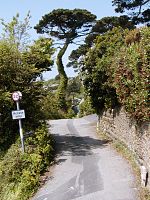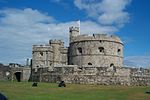St Anthony Head
Carrick geography stubsHeadlands of CornwallNational Trust properties in CornwallTourist attractions in Cornwall

St Anthony Head is a National Trust property situated at the southernmost tip of the Roseland Peninsula, Cornwall, England, United Kingdom, overlooking the entrance to one of the world's largest natural harbours: Carrick Roads and the estuary of River Fal. It preserves the former St Anthony Battery, built in 1895–97 to defend the estuary of the River Fal. The headland is designated as part of Carricknath Point to Porthbean Beach and Lower Fal & Helford Intertidal Sites of Special Scientific Interest. At its tip lies St Anthony's Lighthouse.
Excerpt from the Wikipedia article St Anthony Head (License: CC BY-SA 3.0, Authors, Images).St Anthony Head
Military Road,
Geographical coordinates (GPS) Address Nearby Places Show on map
Geographical coordinates (GPS)
| Latitude | Longitude |
|---|---|
| N 50.141369 ° | E -5.014958 ° |
Address
WW2 Observation Post for Coastal Gun Battery
Military Road
TR2 5HA
England, United Kingdom
Open on Google Maps










